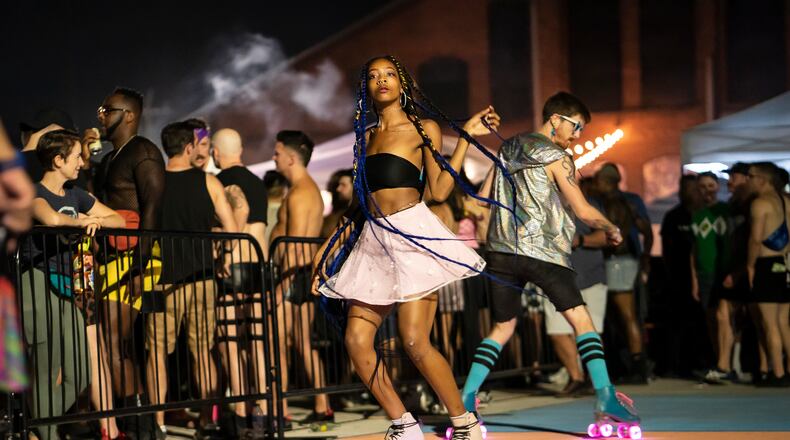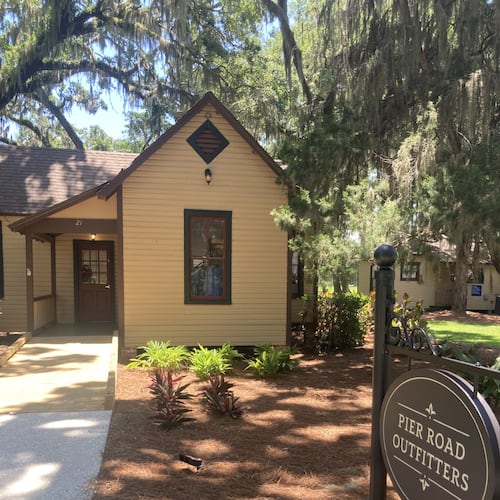Every Thursday evening, the pickleball courts at Pullman Yards transform into a scene that feels straight out of the past. The multiage, multigender, multiracial crowd whirling around the repurposed surface on roller skates or inline skates for the weekly Skate Night is reminiscent of skating’s 1980s high point.
I heard about Skate Night from my friend Sarah Foster Davis who heard about it from one of her friends. Sarah had decided this was the year she would grab more joy. She found it by putting on her skates and hitting the outdoor rink.
“It brings back fond childhood memories of when I came to the States and skating was a big deal,” said Sarah, whose family emigrated from Jamaica in the late 1970s. “For me, a lot of the joy is the music and being able to be out there and dance. It’s the sense of gliding. And when you can catch the beat and be at one with it on skates, it feels sweet.”
There is a lot of nostalgia attached to roller-skating, but during the pandemic the activity attracted a new audience. People who had never been on skates before watched roller-skating videos on social media and decided to give it a try.
There has always been a vibrant roller-skating culture in Atlanta, particularly in the Black community, but when the pandemic sent people scrambling for outdoor activities, skating was a top choice for all residents. Georgia still ranks among the top 10 states on searches for roller skates, according to Google Trends.
In metro Atlanta, as in other cities around the country, skating pop-ups have hit peak popularity. This summer skaters descended on Cook Park for Saturday afternoon sessions. Last year, Science ATL hosted a Science of Roller-Skating event in which participants skated one mile on the Silver Comet Trail and learned the physics behind popular skating moves, while the Skating Experience brought a summer of outdoor skating to Cumberland Mall in Cobb County.
“Every 10 years or so, skating is on the upswing,” said David Ramsey, owner of Southeastern Skate Supply, a wholesale skating supplier founded by Ramsey’s grandfather in the 1940s. “During COVID, a lot of people went outside to skate, especially women. People who haven’t been to a roller rink in years are now going,” he said.
That’s good news for roller rinks and skating pop-ups and for anyone discovering skating, a pastime known as a great lower body workout and mood enhancer. But it’s also good for sustaining a recreational activity that has been such an important part of Atlanta’s culture.
Atlanta got its first roller skating rink in 1869, according to Archive Atlanta, a history podcast focusing on metro Atlanta. Located on Forsyth Street at the railroad tracks, the second floor warehouse space had a stage for bands and separate lounges for men and women. That was a decade before the mass production of roller skates led to the skating boom of the 1880s and rinks began popping up everywhere.
But, as Ramsey said, the popularity of skating is cyclical. By the next decade, rinks began closing. Kids started skating in the streets, which set off a series of city ordinances that forbade skating on asphalt. Segregation meant Black Americans who wanted to skate had to open their own rinks, one of which was located in the Old Fourth Ward in the early 1900s.
Roller-skating would hit one of its highest moments in the 1980s when disco music turned it into the rhythmic dancing on wheels that continues today.
“Atlanta has always had a good core group of skaters,” Ramsey said, but it’s most enduring legacy is in the Black community. “In the suburbs, white kids skate until they start driving and then return when they have kids,” Ramsey said. “There has always been a great core of African American skaters in Atlanta. Once they can skate, they will skate until they are 80.”
Many of the skating rinks are located outside the Perimeter due to the astronomical cost (Ramsey estimates at least $3 million) of building a new rink in the city limits. Stretching from Starlite Family Fun Center in Stockbridge to Skate Country in Buford, many metro area rinks have become cultural icons, including Golden Glide and Sparkles.
As the outdoor skating season winds down, Ramsey predicts the indoor season will be pretty good for local rinks.
My friend Sarah told me she is already on a mission to visit all the different skating rinks in metro Atlanta. Not long ago, I saw her at Sparkles in Smyrna. We were attending a birthday party for kids, but all the grown-ups put on skates and hit the floor. Sarah skated with her daughter and some of the adults, but when she skated alone she was in a groove — gliding around the rink, dancing to the beat and finding her joy.
Read more on the Real Life blog (www.ajc.com/opinion/real-life-blog/) and find Nedra on Facebook (www.facebook.com/AJCRealLifeColumn) and Twitter (@nrhoneajc) or email her at nedra.rhone@ajc.com.
About the Author
Keep Reading
The Latest
Featured



